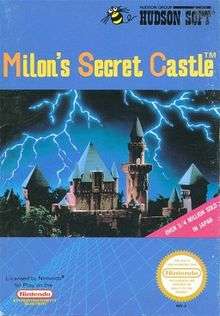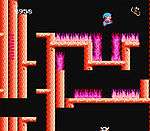Milon's Secret Castle
| Milon's Secret Castle | |
|---|---|
 Cover art | |
| Developer(s) | Hudson Soft |
| Publisher(s) | Hudson Soft |
| Composer(s) | Takeaki Kunimoto |
| Platform(s) | NES/Famicom, Game Boy, PlayStation Broadband Navigator, Virtual Console |
| Release |
1986 i-Revo
|
| Genre(s) | Action, puzzle |
| Mode(s) | Single-player |
Milon's Secret Castle, known in Japan as Meikyū Kumikyoku: Milon no Daibōken (迷宮組曲 ミロンの大冒険 "The Maze Suite: Milon's Great Adventure"), is a 1986 action-adventure game released by Hudson Soft for the NES.[1]
Plot
The protagonist, Milon, lives in the land of Hudson where people use music to communicate with each other. However, Milon does not have the ability to communicate. He always asked himself why he is the only one who lacks the ability to understand people and music. One day he decides to travel throughout the land of Hudson to search for other people like himself. Before leaving for his trip, Milon decides to visit Queen Eliza who lives in Castle Garland (known as "Hudson's Secret Castle" in Japan). When Milon arrives at Castle Garland, the people were being attacked by the Evil Warlord Maharito from the north region. Maharito robs the innocent people, by stealing all their musical instruments and occupies the Castle Garland. Queen Eliza is held captive deep inside Castle Garland by Maharito and his demon-monsters. Milon volunteers to fight the Maharito and his demons and to rescue Queen Eliza and the musical instruments for the people of Hudson. This will not be an easy task. Castle Garland has many different rooms and each room is a maze filled with demons, secret passages and doors. However, the Castle's Magician tells Milon that Queen Eliza has hidden many tools, instruments and money to help him. The Magician also gives Milon a magic "Bubble" to assist him in finding the places where the helpful items are hidden and where they may be bought.
Gameplay
The player controls Milon by running, jumping and shooting bubbles. The player starts out at the bottom floor of a four-story castle, named Castle Garland, and he must work his way upwards, searching the three main stories, the well, two side towers and the very top. If the player stays too long outside of the castle, lightning bolts fall off from the sky. Each room the castle contains many enemies and hidden items. Milon's bubbles are both a tool and a weapon; throwing bubbles at soft blocks causes them to break apart and either create additional routes, reveal hidden shops, or expose specific items. The bubbles can also destroy the demons that inhabit the given rooms, though they will come back to life after several seconds. Each story can only be reached by defeating the first boss. Although seemingly basic, the only way the bosses can even be reached is by discovering a host of secrets, some of which require sheer luck or a helpful manual. This is because there is no visual difference between these "soft blocks" hiding the secrets and the "hard blocks" which are just walls and sometimes you have to be extremely specific about where you have to shoot at. Sometimes after you uncover the spot where the item is, you are even required to waste your time walking around the level before an important item like the key appears. These bosses are much larger than the regular demons and take many bubbles to defeat. They attack by leaping back and forth, spitting out fireballs that take a lot of life off. When a demon-monster dies it stays dead and releases a crystal ball and, at times, make Milon's bubbles larger and make them fly out farther. The demon-monster's room can then be used to get to the next story of the castle. Throughout the entire game the player is only given one life. When one life is lost, the game is over and the player must start over. However, if the player holds left on the control pad while pressing the Start button at the title screen, he or she can start where they left off. This command does not work before collecting the first crystal, and was only featured in the instruction booklet of the Famicom version.
Along the way, Milon will come across various items found in shops; some shops are in plain sight, some are hidden in the differing rooms or outside the castle, and some can be found after Milon defeats a certain demon-monster boss. All of the items augment Milon in one specific way or another, though not all of them are found in shops.

The game has generally been considered by several gamers to be extremely difficult and frustrating. There are no save points, and once a player runs out of life, the game is over; however, it is possible to continue after obtaining the first crystal. The number of continues at your disposal is random, you just have to hold "Left + Start" and hope that your game is saved. Unlike in most platform games of the era, Milon does not "blink" to become briefly invincible when he is attacked by an enemy, which means his energy can be sapped very quickly if he does not move away. This is offset by the fact that each room in the castle has a "honeycomb" which restores your life bar entirely and extends it by one unit.
The game has a rather unorthodox approach when compared to other 2D platformers; the rooms can be accessed in any order, and the rooms themselves do not flow like traditional platformer stages. In each room, there is only one single exit, which is in a fixed spot within the room, but does not appear until you fire a bubble at its hidden location. Navigating a castle's room does not always require simply running from left to right, which gives each room a free-flowing feel. Each room of the castle contains secrets similar to those of the Super Mario Bros. series; the secrets are uncovered by shooting bubbles into invisible trigger objects and breaking soft blocks.
A cumulative side-quest involves finding music boxes. By touching a music box, Milon is transported to a mini-game where he attempts to pick up as many musical notes as possible, with extra points given for sharps and negative points given for accidentally picking up flats. The first time the player reaches the mini-game, only one elf with a drum appears to play the music. Each time the player collects a music box and is transported to the mini-game, a new elf with a new instrument appears, and the song gets more elaborate.
Release
It was released for the Famicom (Japan) on November 13, 1986.[1] It was released for the Nintendo Entertainment System (North America) in September 1988.
While the Game Boy version kept the same title as the NES version's in the US, the game was released in Japan on March 26, 1993 under the name Milon no Meikyū Kumikyoku (ミロンの迷宮組曲 Milon's Maze Suite) and later in North America.[2] The Game Boy version includes a password feature, but is otherwise mostly identical to the NES version. Besides that, there are other obvious differences between the Game Boy and NES versions. First, the room sizes are smaller, likely due in part to the smaller available screen size. As a result, many hidden items and platforms are not in the same absolute position, but can be found in roughly the same relative position. Second, every item costs a little less money than in the NES version. Additionally, there are slightly fewer money tiles to collect, which generally works in favor of the player. The store that gives you $10 in the NES version gives you $15 in this version. Third, the boss fights are substantially easier. You can attack the entire body of the boss, not just the head. Bosses send only one projectile out at a time, and the projectiles are much smaller. The projectiles are more focused on your current position, so they are easier to dodge. Finally, the ending has new illustrations added to it.
Reception
| Reception | ||||||||||
|---|---|---|---|---|---|---|---|---|---|---|
| ||||||||||
GameSpot's Frank Provo described the game as easily one of the worst games ever made.[3] Provo criticized the control scheme, saying Milon "runs like his feet are greased, and his jumps are easily interrupted by nearby blocks that are adjacent or directly above him".[3] Provo awarded Milon's Secret Castle a "terrible" score of 2.0/10.[3]
Legacy
The NES version was rereleased in 2005 as part of a compilation on the Game Boy Advance known as Hudson Best Collection Vol. 3. The same version of the game was also released to mobile phones, the Japan-exclusive Hudson Channel for the PS2 and the Wii's Virtual Console service in Japan and North America and later in the PAL region as an import release.[6][7][8] It was also released on October 31, 2013 on the Nintendo 3DS's Virtual Console service.[9]
In 1996, a Super Famicom sequel to the game was released only in Japan, known as DoReMi Fantasy: Milon no Dokidoki Daibouken.
There are some references to Milon's Secret Castle in a few Hudson Soft games. Milon made a cameo appearance in the Sega Saturn game Saturn Bomberman, and in Star Soldier there are hidden Milon tiles that can only be uncovered and destroyed for a 40,000 point bonus when certain score conditions are met.
In 2006, a Nintendo DS puzzle game was released only in Japan under the title Milon no Hoshizora Shabon: Puzzle Kumikyoku.
Milon's Secret Castle was one of the videogames based for Manga titled Famicom Rocky from 1985 to 1987 and Nekketsu! Famicom Shounendan from 1986 to 1987 published by Coro Coro Comics.
References
- 1 2 "迷宮組曲 ミロンの大冒険 [ファミコン] / ファミ通.com". www.famitsu.com. Retrieved 2018-07-24.
- ↑ "ミロンの迷宮組曲 [ゲームボーイ] / ファミ通.com". www.famitsu.com. Retrieved 2018-07-24.
- 1 2 3 4 Provo, Frank. "Milon's Secret Castle Review". GameSpot. Retrieved January 24, 2017.
- ↑ M. Thomas, Lucas (June 5, 2007). "Milon's Secret Castle Review". IGN. Retrieved March 21, 2014.
- ↑ McFerran, Damien (June 4, 2007). "Milon's Secret Castle Review (NES)". Nintendo Life. Retrieved October 1, 2018.
- ↑ https://www.nintendo.co.jp/wii/vc/vc_mkk/
- ↑ https://www.nintendo.com/games/detail/8JpDQVhA5ZbYxbc80VPozQr65rQ1fSBT
- ↑ https://www.nintendo.co.uk/Games/NES/Milon-s-Secret-Castle-812431.html#Overview
- ↑ https://www.nintendo.com/games/detail/8ZXWfEuxYIWme82h6t4DyFaZ1Icm5MKU